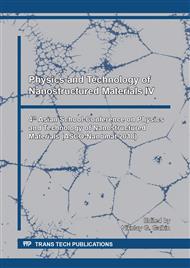[1]
Huang, Y., K.-N. Tu: Silicon and Silicide Nanowires: Applications, Fabrication, and Properties,, Singapore, (2013).
Google Scholar
[2]
H. Tatsuoka, W. Li, E. Meng, and D. Ishikawa, Syntheses of a Variety of Silicide Nanowire and Nanosheet Bundles, ECS Trans. 50 (2012) 3-10.
DOI: 10.1149/05006.0003ecst
Google Scholar
[3]
H. Itahara and H. Nakano, Synthesis and optical properties of two-dimensional nanosilicon compounds, Jpn. J. Appl. Phys. 56 (2017) 05DA02-9.
DOI: 10.7567/jjap.56.05da02
Google Scholar
[4]
E. Bonitz, Lepidoide, VI, Ein neuer Weg zur Herstellung von aktivem Silicium oder Siliciummonochlorid, Chem. Ber. 94 (1961) 220-225.
DOI: 10.1002/cber.19610940133
Google Scholar
[5]
X. Meng, H. Imagawa, E. Meng, H. Suzuki, Y. Shirahashi, K. Nakane, H. Itahara, H. Tatsuoka, Formation of Si-based nanosheets by extraction of Ca from CaSi2 layers on Si substrates, J. Ceram. Soc. Jpn, 122 (2014) 618-621.
DOI: 10.2109/jcersj2.122.618
Google Scholar
[6]
X. Meng, P. Yuan, K. Sasaki, K. Tsukamoto, S. Kusazaki, Y. Saito, Y. Kumazawa and H. Tatsuoka, Formation of Si-based Nanosheet Bundles and Morphological Modification of CaSi2 Crystals by Thermal Treatment using Chloride Compounds, e-J. Surf. Sci. Nanotech. 16 (2018).
DOI: 10.1380/ejssnt.2018.218
Google Scholar
[7]
X. Meng, K. Sasaki, K. Sano, P. Yuan, and H. Tatsuoka, Synthesis of crystalline Si-based nanosheets by extraction of Ca from CaSi2 in inositol hexakisphosphate solution, Jpn J. Appl. Phys. 56 (2017) 05DE02-7.
DOI: 10.7567/jjap.56.05de02
Google Scholar
[8]
Y. Kumazawa, K. Sasaki, P. Yuan, X. Meng, and H. Tatsuoka, Synthesis of powders consisting Si-based nanosheets using silicide powders as templates in acid solution, J. Soc. P. Tech., Jpn 53 (2016) 797-803.
DOI: 10.4164/sptj.53.797
Google Scholar
[9]
M.K. Weldon, V.E. Marsico, Y.J. Chabal, A. Agarwal, D.J. Eaglesham, J. Sapjeta, W.L. Brown, D.C. Jacobson, Y. Caudano, S.B. Christman, and E. E. Chaban, On the mechanism of the hydrogen-induced exfoliation of silicon, J. Vac. Sci. Technol. B15 (1997).
DOI: 10.1109/soi.1997.634964
Google Scholar
[10]
S. Yamanaka, H. Matsu-ura, M. Ishikawa, New deintercalation reaction of calcium from calcium disilicide, Mater. Res. Bull. 31 (1996) 307-316.
DOI: 10.1016/0025-5408(95)00195-6
Google Scholar
[11]
H. Imagawa, N. Takahashi, T. Nonaka, Y. Kato, K. Nishikawa and H. Itahara, Synthesis of a calcium-bridged siloxene by a solid state reaction for optical and electrochemical properties, J. Mater. Chem. A, 3 (2015) 9411-9414.
DOI: 10.1039/c5ta00321k
Google Scholar
[12]
H. D. Fuchs, M. Stutzmann, M. S. Brandt, M. Rosenbauer, 3. Weber, A. Breitschwerdt, P. Deak, and M. Cardona, Porous silicon and silowene: Vibrational and structural properties, Phys. Rev. B48 (1993) 8172-8189.
DOI: 10.1103/physrevb.48.8172
Google Scholar
[13]
P. Yuan, R. Tamaki, S. Kusazaki, N. Atsumi, Y. Saito, Y. Kumazawa, N. Ahsan, Y. Okada, A. Ishida and H. Tatsuoka, Structural and Photoluminescence Properties of Si-based Nanosheet Bundles Rooted on Si Substrates, Jpn J. Appl. Phys. 57(2017).
DOI: 10.7567/jjap.57.04fj01
Google Scholar
[14]
R. Fu, K. Zhang, R. P. Zaccaria, H. Huanga, Y. Xia, Z. Liu, Nano Energy 39 (2017) 546-553.
Google Scholar
[15]
L. Sun, T. Su, L. Xu, M. Liu and H.-B. Du, Two-dimensional ultra-thin SiOx (0 < x < 2) nanosheets with longterm cycling stability as lithium ion battery anodes, Chem. Commun. 52 (2016) 4341-4344.
DOI: 10.1039/c6cc00723f
Google Scholar
[16]
M. Chemla, S. Durand-Vidal, S. Zanna, S. Petitdidier, D. Levy, Silicon surface wet cleaning and chemical oxide growth by a novel treatment in aqueous chlorine solutions, Electrochimica Acta 49 (2004) 3545-3553.
DOI: 10.1016/j.electacta.2004.03.023
Google Scholar
[17]
A. Stapf, P. Nattrodt and E. Krokez, On The Mechanism of the Anisotropic Dissolution of Silicon in Chlorine Containing Hydrofluoric Acid Solutions, J. Electrochem. Soc. 165 (2018) H3045-H3050.
DOI: 10.1149/2.0061804jes
Google Scholar


